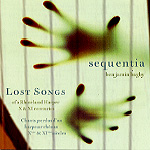What do you do when you want to perform 1000-year-old songs but have absolutely no idea what they sounded like, or even exactly how to interpret the information in the existing ancient manuscript sources? You muster all of your considerable musicological knowledge and early-music performing experience, gather together some of the most capable specialists in the field–and go for it. Some listeners will rightly question the purpose of a project to which no accurate measure of authenticity can be applied, while others will simply enjoy the sound of harp, lyre, and flute, along with the pure-voiced, dynamic, ardent singing of Benjamin Bagby, Agnethe Christensen, and Eric Mentzel in “re-creating” these songs from the Rhineland, France, and Italy.
The program is divided into three sections–“Songs of the Harp”, “The Image of Dawn”, and “Desire and Seduction”–and in his excellent liner notes, Bagby effectively sets us up with a historical context for the music and a detailed description of each song’s origin and meaning. Consequently, we can listen with an appreciation for the musical resources these committed performers are working with, and we can at least accept their interpretations (partially if not fully) as sincere and even credible. There’s considerable variety from song to song in terms of vocal and instrumental combinations, however the melodic material is characterized by decidedly modal structures that lend a certain sameness to the tunes, alleviated only by the often complex rhythmic formulations. The sound is vibrant, clear, and immediate, with fine balances between voices and instruments. This recording by the world-class Sequentia ensemble for medieval music will appeal primarily to early-music aficionados, who will find enough familiar reference-points among these 16 songs to feel at home in a “long-lost world of an unknown Rhineland entertainer and his 11th-century audience.”
































